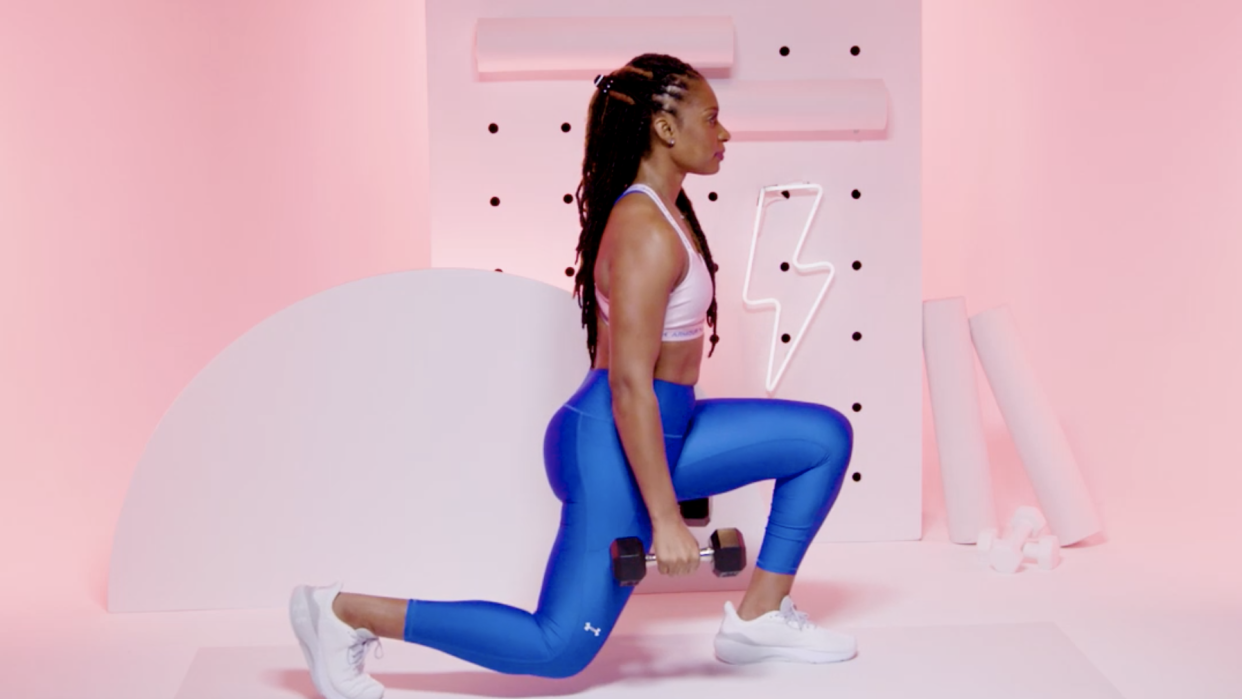Working This Often-Neglected Muscle Group Can Help Nix Lower Back Pain

Most people focus on the major leg muscles like the quads, glutes, and hamstrings on lower body days, often while totally neglecting inner-thigh exercises. But the inner thigh muscles are responsible for pulling your legs together and stabilizing and supporting the pelvis, so strengthening them can lead to noticeable benefits when it comes to athletic performance and everyday activities.
What are the inner thigh muscles?
The inner thigh muscles (A.K.A. your adductors) are key players when it comes to keeping your hips and lower back in a neutral position, which helps prevent the back from overarching *and* the aches and pains that come with it, says Kehinde Anjorin, CPT, a functional strength coach, personal trainer, and founder of ThePowerMethod. Five different muscles make up this group—the gracilis, obturator externus, adductor brevis, adductor longus, and adductor magnus—says physical therapist and exercise physiologist Milica McDowell, DPT.
Generally speaking, these muscles run from the pelvis to the inside of the thigh, and work together to pull the legs towards the midline as well as to bend, extend, and rotate the thigh inward at the hip, she explains. Strong inner thigh muscles also help to create definition and tone in your upper legs. (Think killer legs like Carrie Underwood's, Christie Brinkley's, and many more.)
Meet the experts: Kehinde Anjorin, CPT, is a functional strength coach, personal trainer, and founder of ThePowerMethod. Allison Jackson, CPT, is a personal trainer and founder of Allison Rose Jackson. Milica McDowell, DPT, is a doctor of physical therapy, exercise physiologist, and owner of Clearwater Physical Therapy.
Benefits Of Inner Thigh Exercises
The inner thigh muscles help support the hips and core during various movements, so training them can help improve overall lower body strength and stability, says Allison Jackson, CPT, a personal trainer and founder of Allison Rose Jackson. They’re also MVPs when it comes to maintaining good mobility and balance through the lower body and torso, she adds.
Plus, when you’re moving and active (think walking, running, playing pickleball, or cycling), your inner thigh muscles make it possible to repeatedly lift and lower the legs, so strengthening them helps to ensure smooth and efficient lower body functioning, says McDowell.
Pro tip: Most inner thigh exercises are considered compound movements, which mean they hit more than one muscle group at a time, says Anjorin. There’s a big misconception that if you want to tone a specific muscle group—like the inner thighs—you must work them in isolation, but the body really doesn’t work that way. Instead, compound movements maximize efficiency and overall strength gains.
The Best Inner-Thigh Workout
Long story short, the inner thigh muscles are key players when it comes to having strong, toned legs. They may not be the main characters of leg day, but do deserve some extra lovin’. And while Jackson says you can train your inner thighs through pilates, yoga, running, or biking, there are a few ways to maximize your time while setting your adductors on fire: lateral (or side-to-side) movements and single-leg exercises.
With the 16 trainer-selected inner thigh exercises outlined below, you can create your own workout that matches your ability, fitness level, and timeframe.
Time: 15 minutes | Equipment: Body weight (resistance band, or weights optional) | Good for: Legs, lower-body
Instructions: Choose at least three moves below, including at least one single-leg and one lateral exercise. Perform 10 reps of each exercise, then immediately continue on to the next. Once you've finished the chosen movements, rest for 45 seconds, then repeat twice more for a total of three rounds. Aim to incorporate these moves at least two to three times per week for best results.
Quick Tips For Total-Body Toning
Don’t forget your upper body: These moves form an awesome lower-body routine, but be careful not to overdo leg day. If you prefer a split training method, where you target specific muscle groups in each session instead of a full-body workout, aim to train upper body twice a week and lower body three times a week. Or, you can combine both for a full-body workout by including three lower-body movements and three upper-body movements in one session.
Prioritize quality sleep: When it comes to toning all-over, sleep is an underrated variable. It factors into how you show up in the gym, how much energy you have before and after a training session, and also impacts your cortisol levels. The more sleep you have, the lower your cortisol (which is a fat-producing hormone). Sleep is very, very important and really ties together the outcomes you're looking for when it comes to building strength and staying in shape.
Think strength, then cardio: If you're looking for toning and sculpting, don't rely too much on cardio, although it should be a part of your overall fitness routine. (Remember: Cardio is anything that elevates your heart rate—dancing, skipping, and rollerskating are just a few unconventional examples. It’s not just relegated to running on the treadmill.)
Be consistent: If you’re doing all of the above, and showing up consistently, you're going to get results. Find a routine that works for you, and stick with it.

You Might Also Like


